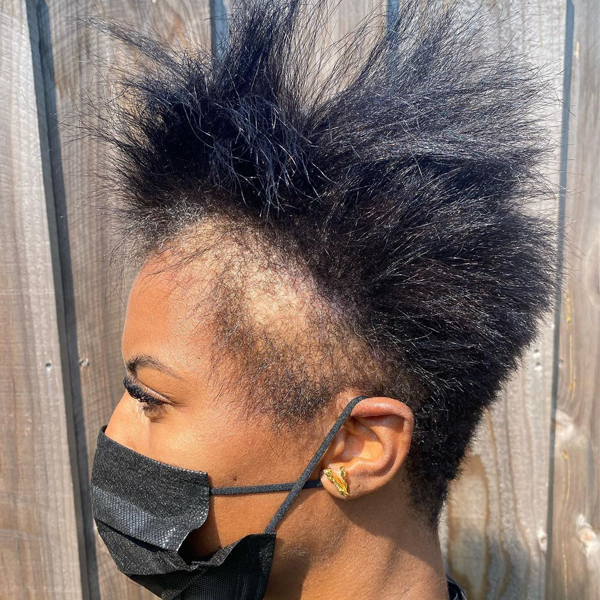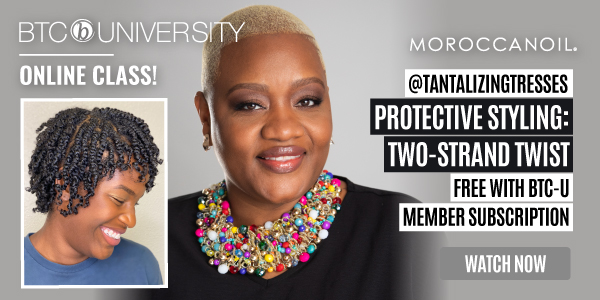Clients Experiencing Hair Loss? Here’s Why!
Traction Alopecia: When Protective Styles Cause More Harm Than Good
We all love a good transformation and Jasmine Collins a.k.a. @theofficialrazorchic delivers every time! With over 800k followers on Instagram, she draws in stylists and consumers alike with her jaw-dropping hair loss before and afters.
A lot of her clients haven’t worn their real hair in years before sitting in her chair, choosing to cover their hair loss in extensions and wigs as the damage intensifies underneath. Have you noticed something similar happening with any of your clients?
If so, you’re in luck! BTC spoke to Jasmine on EVERYTHING traction alopecia, including how to treat it, choosing styles that work and spotting irreversible damage. Keep scrolling for the info!
What Is Traction Alopecia & What Causes It?
Traction alopecia is caused by “repeated trauma to hair follicles or from pulling your hair back into tight hairstyles,” according to WebMD. Tight hairstyles can cover a variety of looks, but the main culprits are ponytails, braids, extensions and even wigs.
“[Traction alopecia] comes from the tight pulling and smothering [of the hair]…The smothering comes from the wigs—from a full unit laying on [the client’s] hair for weeks at a time,” says Jasmine. “Hair is like a plant. It has to have oxygen. It has to breathe… Because, so many people are in these wigs from day to day, it really kills the hair follicles.”
Click here to learn about the different types of scarring alopecia!
Can Hair Grow & Recover From Traction Alopecia?
“It depends on how bad it is,” says Jasmine. “But, I will tell you [the hair] will definitely be in a much better state after me or someone else frees them, so they will not have to continue smothering their hair.”
The earlier the client stops using restrictive styles, the better the chance of recovery. “Now, I have some return clients that do come to me…and I can see the hair resprouting. In fact, I have one person in mind that every time I see her it blows my mind, and it makes me feel proud that I’m doing the right thing freeing so many people.”

When Does The Scarring Become Permanent?
How do you know when the client has reached the point of no return with their hair? Jasmine says it’s when you start to see a white bulb at the end of their hair through the scalp. “Once that bulb comes out, it’s a wrap. If you start seeing hair and it has a bulb on the end of it, you’re literally pulling it from its base.”
Braids are an integral part of Black styling, from standalone styles to laying the hair down under wigs and sew-in extensions. But, prolonged use without any breaks in between can tear out your clients hair.
“I always tell people tight braiding is another form of tweezing, like [when you] get the tweezers to pull the hair from your chin? The more you pull the hair from your chin, the strand gets finer and finer because you’re pulling it from its root…until it eventually dies and it’ll be smooth like the back of your hand… That’s the same thing you’re doing with your hair follicles. The more you keep griping the hair from the bulb, the hair strand is going to get finer until it eventually dies,” she adds.
Watch Jasmine Transform A Hair Loss Client!
View this post on Instagram
How Do You Treat Traction Alopecia In The Salon?
First, start with a consultation. Ask the client their hair and medical history to figure out what might be causing their hair loss and how to proceed from there. It might seem invasive asking the client for personal medical information, but if the condition or medication your client is taking contributes to hair loss, you need to know.
After you assess the hair, give it what it needs! As a stylist, all you can do is treat the hair, not the condition. “If the hair is dry, I definitely recommend doing a hydration treatment,” says Jasmine. “I will use a honey mask and put them under the steamer for 30 minutes to add moisture back into the hair. Now, if they come in and the hair [feels] like the elasticity is gone or it’s shedding really bad, it needs protein. So, I’ll do a protein treatment to rebuild the hair when they’re coming in.”
Looking for a more detailed breakdown of how Jasmine styles and prices her services? Click here!

How Can Stylists Work With Dermatologists On Hair Loss?
“I’m not a dermatologist, nor am I a trichologist. I’m just a really dope, talented hairstylist that knows how to camouflage and give people nice, pretty haircuts and colors. But, I always recommend [my clients] to go see a hair loss specialist, so they can look at their scalp and look underneath to see exactly what is going on,” remarks Jasmine.
“I’ve even had dermatologists hit me up telling me, ‘Thank you.’ Because so many Afro American women come into their office to get their hair back and they prescribe them topical medication. They prescribe them internal medication, but they continue to wear the weaves,” she adds.
“It’s like they’re wasting their time and wasting their money coming to see them… So, I realized I’m like the buffer in between the dermatologists and them being stuck in the weaves… [I] give them a nice cut so they can feel confident wearing their own hair, while they’re getting some type of treatment.”
How Do You Encourage A Client To Wear Their Natural Hair?
“Most times, when clients come to me…I let them know exactly what is going on with their hair. I even give them a mirror and stand them up and let them see the back of their hair, all around their hair, at the crown of their head, because some of them don’t even realize it’s as bad as it is,” says Jasmine.
“I let them know, I hope you know you came to me just in time and I was your last stop. I was your last stop from you being completely bald.”

Clients with hair loss or thinning hair? Read this!










